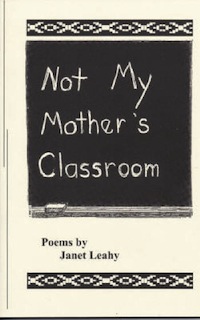Book Review
Janet Leahy, Not My Mother’s Classroom, Poetry People Press, 2012
by Richard Swanson
All too often these days , I think, journalism’s coverage of American education seems deplorably shallow. Pundits and reporters fixate on statistics, theories, celebrity superintendents, and educator hucksters. Prominent in this TV/newspaper myopia are the notions that all our schools are on life support, and our students doomed.
If you’d like a different context for viewing real-life schools, step into the pages of “Not My Mother’s Classroom,” where Janet Leahy, an inner city teacher in Milwaukee for thirty years, gives you a picture of actual life there. Her book’s story poems will both depress and uplift you. More to the point, they will challenge you to filter news headlines through a different prism, beyond the usual rehash of math and reading test-scores.
Many of these works recount Leahy’s daily interactions with her charges, elementary school kids with pummeling odds against them: dangerous neighborhoods (with roaming rapists and daily gunfire), abused mothers, young mothers with zero parenting skills, children floating between multiple foster homes, kids whose grandparents are dads and moms, and kids with imprisoned fathers.
In “The Neighborhood” Leahy gives us a snapshot of her teaching surroundings:
My classroom is on the second floor
of a school built in 1905
From the third floor
a fire escape crawls down brickwork like
a serpentine sculpture
Swings and slides fill a corner
of the blacktop playground
We have no parking lot
Then she profiles the local streets:
Porches hold old sofas
Shades in the houses are drawn
Flashing lights around the corner
come from a movie house
showing adult films
Tough stuff to digest, these images, but then
As I approach my car
a teenager across the street
picks up a rock
and yells
white bitch
and if that’s not enough shock, the poem ends with
As I get in the car
the rock slams into the door just
above the window
My hand shakes as I
put the key in the ignition
spasms jerk my knee.
The poems in this book are simple in appearance, and developed with simple facts, the “who, what, when, and where” bricks of old-time newspapering:
“Danny”
Comes to school
without socks
shoes wet from the snow
feet numb
tears frozenand “Walking to School,” rivetingly grim,
One of my students
arrives thirty minutes lateThrough her sobs she tells me
something bad happenedHe pulled me into the alley
He was a bad man she saysThe police are called
Her mother comesThe little girl cries during
the questioningRolls her body into a ball
The last half of “Not My Mother’s Classroom” shifts into a series of uplifting poems that describe the small triumphs of Leahy’s students: growing self-awareness, delight in new experiences, and enhanced appreciation of education. Many of these experiences involve Leahy introducing her charges to art and culture: field trips to hear the Milwaukee Symphony Orchestra, to view art at the museum, and to hear an African-American poet read at a bookstore.
In the opening lines of “Peter and the Wolf” Leahy catalogs the delights of kids listening to the MSO playing Prokofiev:
Rows of young children
sit on the edge of their seats
mesmerized
seeing music being made
Briance moves a bow over a pretend violin
Nick’s fingers travel an imaginary fluteSix-year-old Alicia
sits cross-legged in her seat
eyes fixed on the musicians
She waves her arms
like the maestro
Additional poems of this kind recount trips to farms, and students performing at Christmas programs. One of them, artfully titled “Do You See What I See?” ends with a mini-lesson in how rigid perceptions of race can charmingly soften, as people work together over time:
When the program ends
Sierra’s third grade sister Shanna
comes to our classroom
to pick up her little sister
As they leave both give me a hug
Shanna turns and says
I never hugged a white person before
Her little sister answers
Ms. Leahy’s not whiteShe is
She’s not
she is
she’s not . . .
As evidenced in this work, one of Leahy’s great talents is creating thoughtful endings for poems, and part of the strategy of “Not My Mother’s Classroom” involves the author creating a warm, human atmosphere within a work, but then jarring us with a comeuppance at its conclusion. The poem about the kids at the symphony concert ends with an angry moment, the teacher-poet noting
The evening news
reports budget cuts
for music programs
in city schools.
In the same way, the poem about the field trip to the farm concludes with a line freighted with understated meaning:
Cedric and Bobby liked the long bus ride
Danny thought the piglets were great
When his turn comes Jashaun says
The best thing about the trip to the farm
was going with Eric’s daddy
he was nice to me
All in all, “Not My Mother’s Classroom” is persuasive poetry with messages that go directly at the reader’s mind-sets. Educating inner city kids is tough work, Leahy says, given the neighborhoods that house them. Students can succeed if people believe in them. Arts education is woefully undervalued.
This poet-educator’s work is deftly instructive, and the power of Leahy’s book is also enhanced by well-placed, telling illustrations by Edith DeBrue.
Richard Swanson is the author of two collections Men in the Nude in Socks and Not Quite Eden and a chapbook (Paparazzi Moments), from Fireweed Press. A frequent reviewer for Verse Wisconsin, he is also the Secretary of the Wisconsin Fellowship of Poets.


